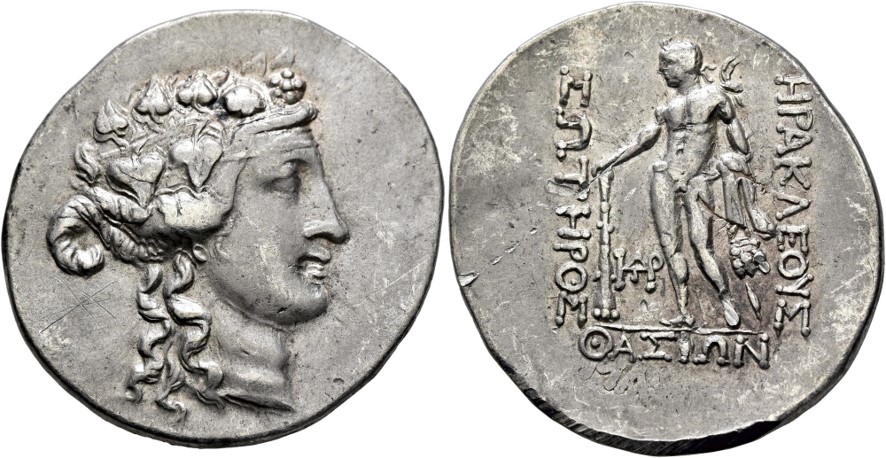90 BCE - 60 BCE | ΗΡΑΚΛΕΟΥΣ / ΣΩΤΗΡΟΣ / ΘAΣIΩN
Overstriking coin
Thasos_on_Aesillas_Leu_Numismatik,_EA_31,_7_Sept._2024,_269.jpg
[1]
Overstruck variety
Aesillas 2nd group.jpg
|
|
Sale(s)Sale(s) ᵖ:
|
Leu Numismatik, EA 31, 7 Sept. 2024, 269
|
| Private collection(s)Private collection(s) ᵖ:
|
From a European collection, formed before 2005
|
|
Description
| ObverseInscription or printing placed on the obverse.:
|
Wreathed head of young Dionysos right
|
ReverseInscription or printing placed on the reverse.:
|
ΗΡΑΚΛΕΟΥΣ / ΣΩΤΗΡΟΣ / ΘAΣIΩN (Greek) Herakles standing left, nude but for lion's skin over his shoulder and left arm, resting right hand on club, in the inner left field, monogram
|
Mint and issuing power
| MintIdentifies the place of manufacture or issue of a numismatic object.:
|
Thasos
|
Ancient regionAncient region.
|
Thrace
|
Modern countryModern country: Greece
|
AuthorityIdentifies the issuing power. The authority can be "pretended" when the name or the portrait of X is on the coin but he/she was not the issuing power. It can also be "uncertain" when there is no mention of X on the coin but he/she was the issuing power according to the historical sources:
|
Roman Republic
|
Chronology
| FromIdentifies the initial date in a range assigned in a numismatic context. 90 BCE toIdentifies the final date in a range assigned in a numismatic context.. 60 BCE
|
Hellenistic 323-30 BC  periodTime period of the numismatic object. periodTime period of the numismatic object.
|
Physical description
MetalThe physical material (usually metal) from which an object is made.: Silver 
|
WeightWeight of the numismatic object (in grams). in grams: 16.4916.49 g <br />16,490 mg <br />
|
DenominationTerm indicating the value of a numismatic object. Examples: tetradrachm, chalkous, denarius.: tetradrachm 
|
AxisDescribes the directional relationship between the obverse and reverse of a numismatic object.: 1212 mm <br />1.2 cm <br />
|
| DiameterDescribes diameter of an object (in mm).: 3636 mm <br />3.6 cm <br />
|
StandardStandard.: Attic
|
References
Description
| ObverseInscription or printing placed on the obverse.:
|
MAKEΔONΩΝ (Greek) Head of Alexander the Great right.
|
ReverseInscription or printing placed on the reverse.:
|
AESILLAS (Latin) Fiscus, club and subsellium. All within oak wreath.
|
Mint and issuing power
Chronology
| FromIdentifies the initial date in a range assigned in a numismatic context. 95 BCE toIdentifies the final date in a range assigned in a numismatic context.. 60 BCE
|
Hellenistic 323-30 BC  periodTime period of the numismatic object. periodTime period of the numismatic object.
|
Physical description
| DenominationTerm indicating the value of a numismatic object. Examples: tetradrachm, chalkous, denarius. ᵖ:
|
tetradrachm 
|
StandardStandard. ᵖ:
|
Attic
|
References
| Frequency of overstrikesFrequency of overstrikes:
|
frequent
|
Level of confidenceLevel of confidence of the identification:
|
strong
|
| RemarksRemarks:
|
". This coin was apparently overstruck on a Lysimachos type tetradrachm, as evidenced by the faint traces of [ΛΥΣΙ]ΜΑΧ[ΟΥ] appearing below the ethnic" (nb: not Lysimachus but Aesillas instead)
|
References
- ^ Prokopov, Ilya (2006), Die Silberprägung der Insel Thasos und die Tetradrachmen des "thasischen Typs" vom 2.-1. Jahrhundert v. Chr., Griechisches Münzwerk, Berlin, 342 p., 118 p. of plates
- ^ Hoover, Oliver D. (2010), The Handbook of Greek Coinage Series, volume 6 : handbook of coins of the islands: Adriatic, Iionian, Thracian, Aegean, and Carpathian seas (excluding Crete and Cyprus), sixth to first centuries BC, Lancaster, 358 p.
- ^ Callataÿ, François de (1996), "Les monnaies au nom d'Aesillas", in T. Hackens (ed.), Italiam Fato Profugi Hesperinaque Venerunt Litora. Numismatic Studies Dedicated to Vladimir and Elvira Eliza Clain-Stefanelli, Numismatica Lovaniensia 12, Louvain-la-Neuve, p. 113-151.
- ^ Bauslaugh, Robert A. (2000), Silver coinage with the types of Aesillas the Quaestor, Numismatic Studies 22, New York.


